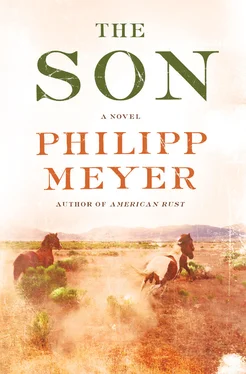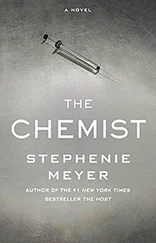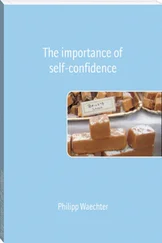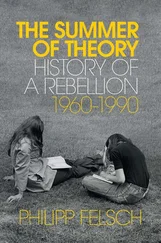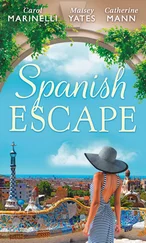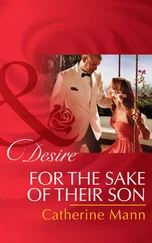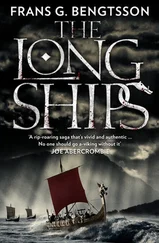I realize he is not any worse than our neighbors: they are simply more modern in their thinking. They require some racial explanation to justify their theft and murder. My brother Phineas is truly the most advanced among them, has nothing against the Mexican or any other race, he sees it simply as a matter of economics. Science rather than emotion. The strong must be encouraged, the weak allowed to perish. Though what none of them see, or want to see, is that we have a choice.
I heard my father knocking things around inside the house. On a horse he still looks like a young man; on the ground he carries the weight of all his years. Watching him shuffle with the jugs of kerosene I could not help feeling sorry for him. Perhaps I am insane.
I followed him into the house. I could knock him over and take the kerosene away. But it was too late. This was only a formality.
Inside everything was covered with dust that had blown in the open doors and windows, the tracks of animals were thick, the blood dried to an indistinct black stain. In the living room, my father had pushed the furniture into a pile and sloshed oil over it. I followed him into the rest of the house, into the bedrooms and then Pedro’s office.
He pulled all the papers from their cabinets, old letters, stock records, deeds, certificates of birth and death for ten generations, the original land grant, back when this area was all a Spanish province, Nuevo Santander.
After everything was doused in coal oil, he struck the match. I stood watching the papers curl, the fire spreading across the desk and up the wall onto a large map of the state, drawn when all the sections had Spanish names. I heard someone calling my name — Pedro. Then I realized it was my father. I went to look for him and when I walked out of the office the entire house was filled with smoke; he’d lit fires in the other rooms.
I bent beneath the smoke, looking into Pedro and Lourdes’s bedroom. Their bed was beginning to burn; the canopy caught and flared and the light filled the dark room. I wondered how many generations had been sired there and knew the Colonel must have thought the same thing.
Through the flames I saw a dark shape calling me forward and only with effort did I turn and make my way toward the sunlight. When I reached the outside my father was already limping down the hill toward the Garcias’ stock buildings, a jug of fresh coal oil in each hand.
Chapter Sixteen. Eli/Tiehteti, The Buffalo
The Comanches owned all the territory between Mexico and the Dakotas, the most buffalo-rich land on the continent. The northern bands hunted them seasonally, but the Kotsoteka, whose home territory was the center of the range, hunted year-round. In summer they hunted the bulls, because they were fattest, and in winter they hunted the cows. Until the age of three summers, the meat of either animal was equally good; older than that and the cows tasted better. Old bulls were mostly killed for their hides.
The animals were hunted with either a lance or a bow. Using the lance required a bit more backbone; you had to match speed with the buffalo and drive the lance, one handed, through the ribs, through the lights and into the heart. At the first prick the animal would turn and try to gore you or crush you against the other running buffalo. The only safety was to go all in, give yourself totally to the lance, to use the animal’s own weight to drive the point deeper. Unless you were crushed first.
The average buffalo was twice the size of a cow and as mean-spirited as a grizzly. They could jump over a man’s head if they wanted, though they rarely did, and if your horse stumbled, or stepped in a prairie dog hole, you could lay money that there would be nothing left of you to bury, as buffalo, unlike horses, would go out of their way to trample you.
The bow gave more wiggle room, as the animal could be killed from a short distance, a few yards, shooting the arrow at a steep angle behind the last rib. Just the same, as soon as the buffalo felt it’d been stuck, it would turn and try to gore you. The best horses would veer at the sound of the bowstring, and this quarter-second gap was usually enough to keep you alive.
Until the big Sharps rifles came along, the buffalo had to be killed while running, from behind and to one side, and so a group of riders would whip the animals into a stampede, and then, by running their horses in front of the lead animals, turn the herd and force the buffalo into a mill, a running circle. Then the hunters would begin the killing.
When as many animals had been killed as could be cut up in a day, the herd was released from the mill and would disappear across the prairie. The fallen buffalo were butchered where they lay, though butchering is not the right word. The Comanche were like surgeons. The skin was cut carefully along the spine, because the best meat and the longest sinews were just underneath, and then the hide was peeled off the animal. If the village was close, by this point a group of optimistic children would have gathered and would be pestering the butcher for a piece of hot liver with the bile of the gallbladder squeezed over it. The stomach was removed, the grass squeezed from it, and the remaining juice drunk immediately as a tonic, or dabbed onto the face by those who had boils or rashes. The contents of the intestines were squeezed out between the fingers and the intestines themselves either broiled or eaten raw. The kidneys, kidney tallow, and tallow along the loins were also eaten raw, as the butchering continued, though sometimes they were lightly roasted, along with the testicles of the bull. If grass was scarce the contents of the stomach were fed to the horses. In winter, in the case of frostbite, the stomach was removed whole and the frostbitten hand or foot thrust in and allowed to warm; recovery was generally complete.
If water was scarce, the veins of the animals were opened and the blood drunk before it had time to clot. The skull was cracked, the brains stirred on a rawhide and eaten as well, being fatty and tender; the teats of any lactating cows were cut and the warm milk sucked directly from them. If the brains were not eaten immediately they were taken to tan hides; every animal has enough brains to tan its own hide, except the buffalo, which was too large.
Once emptied, the stomach was rinsed, dried, and used as a water bag. If there were no metal pots, food could be cooked in the stomach by filling it halfway with water and adding hot stones until the water boiled. Another popular water carrier was the whole skin of a deer, which, if it were to be used for that purpose, was cased and removed whole, and the ends sewn shut. But we are talking about the buffalo.
Once the organ meats were consumed, the hunters retired and the women took over the harder work of butchering. The meat was cut from the bones in three- to four-foot lengths. The strips were placed on the clean inner skin of the recently killed animal and when the animal’s skin was completely full of its own meat, it was wrapped up, tied, put on a horse or travois, and taken back to camp to be dried. After which it was packed into oyóot u, or rawhide containers, and sewn shut with the animal’s sinew. Once dry, the meat would keep indefinitely.
The tongue, hump, side ribs, and hump ribs were all choice cuts and were usually saved for barbecue. The bones were cracked and cooked and the buttery marrow, tuhtsohpe?aip u, scooped out to be used as a sauce alone, or, as previously mentioned, mixed with honey to make a sweet sauce, or cooled and mixed with pounded mesquite beans for dessert.
The shoulder blades were turned into shovels and hoes. The smaller bones were split, fire hardened, and whittled into needles or awls, or into knives, arrowheads, and scrapers. The hooves were boiled to make a glue used for saddle making, attaching sinew to bows, and nearly everything else. Every brave kept a small amount of this glue for emergency repairs. The horns were used as carriers for the fire drill, and, of course, for gunpowder.
Читать дальше
